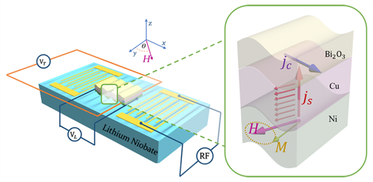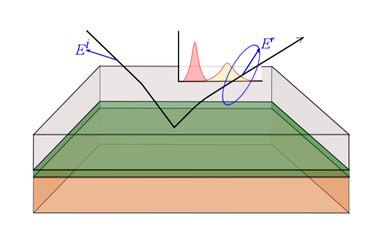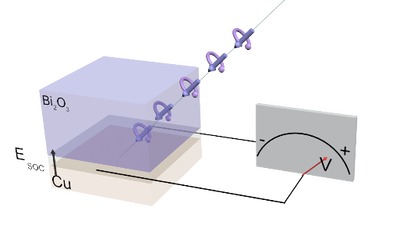|
Context of project
Spin pumping is a mechanism in which a flow of angular momentum or spin current is generated. One of the most common methods to pump spin current is via ferromagnetic resonance (FMR), in which the magnetization of a ferromagnet is driven into precession in resonant condition. If a non-magnetic metal is attached to the ferromagnet the FMR pumps spins into the non-magnetic metal [1]. The FMR is usually driven by microwave photons generated in a coplanar waveguide. An alternative is to drive the FMR by phonons which couple to the magnetization via the magneto-elastic effect, this is known as acoustic FMR and the consequent pumping of spins as acoustic spin pumping [2, 3]. In this project we excite acoustic FMR by coupling surface acoustic waves (SAWs) at GHz frequencies with ferromagnetic layers grown on top of a piezoelectric substrate. The generated spin current is detected and studied by the inverse Edelstein effect induced at interfaces with Rashba spin orbit coupling or the inverse spin Hall effect in heavy metals. Spin pumping reference: [1] journals.aps.org/prl/abstract/10.1103/PhysRevLett.88.117601 Acoustic ferromagnetic resonance and spin pumping references: [1] journals.aps.org/prb/abstract/10.1103/PhysRevB.86.134415 [2] journals.aps.org/prl/abstract/10.1103/PhysRevLett.108.176601 Our work Based on acoustic spin pumping experiments we have demonstrated efficient spin to charge conversion, comparable to that of more standard microwave photon excited ferromagnetic resonance (FMR). In our experiments we generate surface acoustic waves (SAW) in a piezoelectric substrate (LiNbO3) and couple the SAW to a Ni layer which injects spin current into a interface with spin orbit coupling which allow us to convert the spin current to voltage by the "inverse Edelstein effect". Read more Inverse Edelstein effect induced by magnon-phonon coupling M. Xu, J. Puebla, F. Auvray, B. Rana, K. Kondou, Y. Otani Physical Review B 97 (18), 180301 (2018) journals.aps.org/prb/abstract/10.1103/PhysRevB.97.180301 arXiv: arxiv.org/abs/1805.07900 Highlights: www.riken.jp/en/news_pubs/research_news/20180720_FY20180019/ Personal contribution: Project leader (corresponding author), proposed project, supervised experiments and data analysis, writing of manuscript
0 Comments
Context of project
The two-dimensional electron gas (2DEG) is a physical concept that allows to model the behavior of electrons confined in two-dimensions, such as at interfaces and quantum wells. The controlled formation of 2DEGs in between high crystal-quality semiconductors and the consequent electron mobility enhancement allowed the development of various field effect transistor designs pushing forward the electronic industry. Additional, the electron confinement resulted in quantization of electronic states, and the emergence of new physical phenomena such as the fractional quantum Hall effect. The continuous development of growth techniques nowadays allow to grow high quality oxide heterostructures with the corresponding formation of novel 2DEG. The electronic structure of 2DEG in oxide interfaces is different from the most standard semiconductor counterparts. In most of the oxide interfaces, the transport properties are dominated by narrow d-band electrons, whereas in semiconductors the electrons localized at states at the bottom of the conduction band dictate the properties of the 2DEGs. Even more intriguing, is the recent evidence of 2DEG like-behavior at interfaces formed between amorphous oxides. Further studies and understanding of these novel 2DEG are necessary, however, the low crystalline quality of these interfaces drastically complicates the characterization by well-known techniques such as angle resolved photoemission spectroscopy (ARPES). In this project we take a different approach. In collaboration with researchers in Mexico (IICO-UASLP), we characterized the amorphous interfaces by angle resolved infrared ellipsometry and obtain information of the dielectric functions by independent theoretical models and knowledge of the underlying physics. With this methodology we are able to obtain valuable information of the conductivity of the 2DEGs and relativistic effects such as the presence of spin orbit coupling. 2DEG at complex oxide interfaces reference: [1] www.annualreviews.org/doi/abs/10.1146/annurev-matsci-070813-113552 Our work Based on infrared spectroscopic ellipsometry and theoretical modelling, we revealed the properties of a 2DEG formed between a metal and amorphous oxide, and elucidate the presence of spin orbit interaction due to the hybridization of interfacial states as previously suggested for amorphous perovskite oxides. This study proves the feasibility of our methodology for overcoming an experimental impediment which, for decades, has held back important advancements for the understanding of 2DEGs in amorphous materials. Read more: Two-dimensional electron gas in a metal/amorphous oxide interface with spin-orbit interaction J.M. Flores-Camacho, J. Puebla, F. Auvray, A. Lastras-Martínez, Y. Otani, R.E. Balderas-Navarro Physical Review B 100 (23), 235449 (2019) journals.aps.org/prb/abstract/10.1103/PhysRevB.100.235449 arXiv: arxiv.org/abs/1901.08671 Personal contribution: Project co-leader (corresponding author), proposed project, advice on sample properties and guidance on experiments and data analysis Context of project
At interfaces and surfaces the spatial inversion symmetry breaking induces a momentum dependent splitting of spin sub-bands in condensed matter systems. This effect is better known nowadays as "Rashba effect" [1, 2]. Although this effect is the collective result of spin orbit interaction and asymmetry in the crystal potential, it is said that systems which present "Rashba effect" have spin orbit coupling of the Rashba type. One consequence of the Rashba spin orbit coupling is the possibility of converting electrical current to spin current and vice-versa, this is known as the Edelstein effect [3]. The spin current is a flow of angular momentum, which can be generated by the so-called spin pumping, where a given magnetization in a ferromagnetic material precess under a resonant condition (ferromagnetic resonance). In this research project we use the circular polarization of light (or helicity) as source of angular momentum. We couple the light to diverse material systems with Rashba spin orbit coupling and study the generated photovoltage/photocurrent due to the spin to charge conversion mechanism. Currently, at our lab facilities we can do experiments in the optical energy range from 1.1 eV to 3.05 eV, at normal incidence and oblique angles up to 75 deg. Rashba effect references: [1] www.jetpletters.ac.ru/ps/1264/article_19121.shtml [2] iopscience.iop.org/1367-2630/17/5/050202/media/njp050202_suppdata.pdf Edelstein effect reference: [3] www.sciencedirect.com/science/article/abs/pii/003810989090963C Our work We have recently demonstrated the modulation of photovoltage at the Cu/Bi2O3 interface due to spin to charge conversion. Interestingly, even though the Rashba spin orbit coupling was not expected to induced drastic distortion of the electronic bands beyond the splitting of spin sub-bands, in our experiments we detect significant spin to charge conversion above the Fermi level and well-below the band gap of Bi2O3. Our photovoltaic experiments together with density functional theory demonstrates that spin orbit coupling can significantly distort locally the electronic band structure, and in fact, allow new paths for efficient optical absorption with spin information. Read more: Photoinduced Rashba Spin-to-Charge Conversion via an Interfacial Unoccupied State J. Puebla, F. Auvray, N. Yamaguchi, M. Xu, S.Z. Bisri, Y. Iwasa, F. Ishii, Y. Otani Physical review letters 122 (25), 256401 (2019) journals.aps.org/prl/abstract/10.1103/PhysRevLett.122.256401 arXiv: https://arxiv.org/abs/1902.00237 Highlights: www.riken.jp/en/news_pubs/research_news/rr/20190830_FY20190022/index.html Personal contribution: Project leader (corresponding author), proposed project, analyzed data, writing of manuscript |
Jorge PueblaResearch Scientist Archives
October 2020
Categories |



 RSS Feed
RSS Feed
